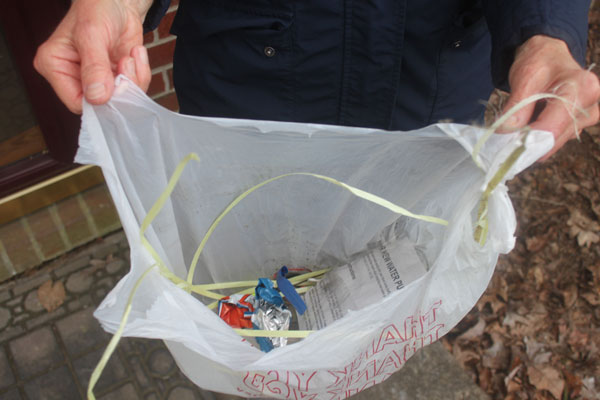Earth Day, April 22, 2023 originated in 1970 after Sen. Gaylord Nelson from Wisconsin witnessed the ravages of the 1969 massive oil spill in Santa Barbara, California. He hoped it would force environmental protection onto the national political agenda. It did lead to the creation of the Environmental Protection Agency, the passage of the Clean Air Act and a dialogue on a host of issues.
In our time it focuses on climate change. The Earth Day theme for 2023, “Invest in Our Planet” is the same theme as 2022.
It starts at home. One of the continuing themes of Earth Day is reducing plastics, our focus at St. Peter this year. On one day walking 20 minutes in our neighborhood, we bagged up these plastics shown in the picture

Plastics in the environment never fully decompose. Instead, they break down into smaller and smaller pieces – eventually into microplastics – that remain in the environment.
Because of their small sizes, toxic microplastics in aquatic environments blend with plankton at the base of the food web. These microplastics are consumed and work their way up into larger and larger consumers, including humans. An estimated 10 million tons of plastic enter the oceans every year. By the year 2050, by weight, there may be more plastic in the ocean than fish.

Steps to Reduction of your use of platics.
The Earth Day 2023 Theme is “Invest In Our Planet. What Will You Do?”
1. Awareness– Enter our contest.
This Saturday, Earth Day, April 22—take a walk and participate in the St Peter’s “trashy contest.” Prizes will be given in the following categories: amount of trash, grossest piece of trash, smallest and largest piece of trash. Bring your entry to church next Sunday, April 23.2. Going further – Calculate your usage.
Before taking action, you need to know your estimated usage of plastics.
The Earth Day site has a plastics calculator this year. Use this calculator to learn about how many plastic items you consume and discard every year.
Consider all the types of plastics you use. For every material listed, you’ll see three boxes. In the first box, fill in your daily consumption of the specific item. The second box will auto-populate with your total consumption every year. The third row is your projected reduction of this type of plastics for the year.
3. Steps to reduce
-
Paper/ such as meat, eggs and cheese from the grocery store
-
Paper cartons
-
Cans
-
Cardboard boxes
-
Glass containers (store food)
-
Wood
-
Metal
-
Cloth
-
Cartons
-
Purchase fresh
-
Corningware
-
Bar soap (Dr. Bonners) to wash dishes
-
Incense for air freshner
-
Perfume in bottle for deodorant
-
Ceramics
-
Clean with baking soda and vinegar instead of cleaners packaged in plastic
-
Line small trash bins in your house with paper bags..
-
Compost your trash, reduce your use of plastic trash bags.
